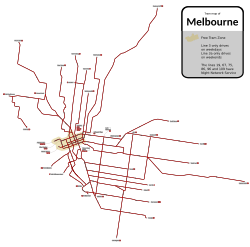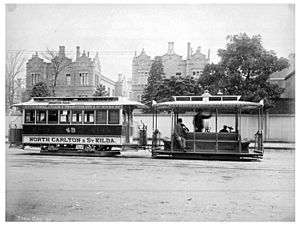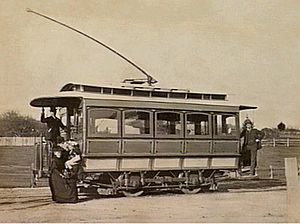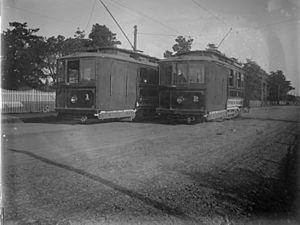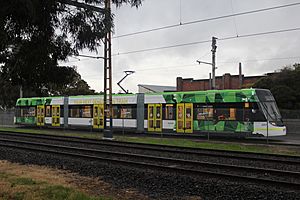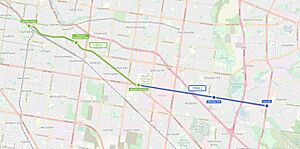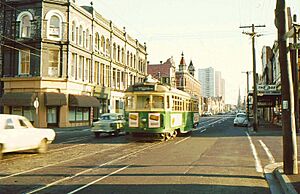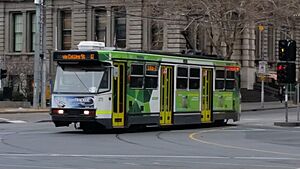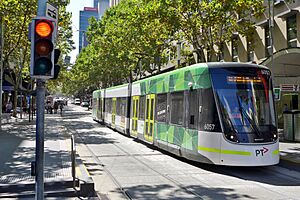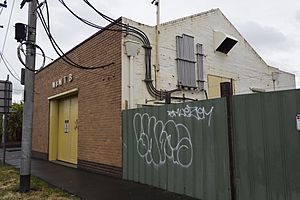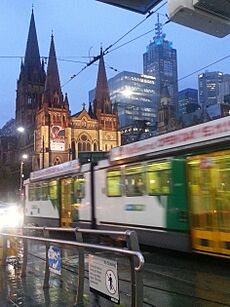Trams in Melbourne facts for kids
| Public Transport Victoria | ||||||||||||||||||||||||||||||||
 |
||||||||||||||||||||||||||||||||
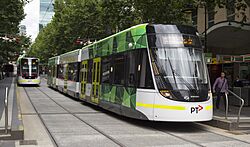
E-class trams on Bourke Street, December 2013
|
||||||||||||||||||||||||||||||||
| Operation | ||||||||||||||||||||||||||||||||
|---|---|---|---|---|---|---|---|---|---|---|---|---|---|---|---|---|---|---|---|---|---|---|---|---|---|---|---|---|---|---|---|---|
| Locale | Melbourne, Victoria, Australia | |||||||||||||||||||||||||||||||
| Infrastructure | ||||||||||||||||||||||||||||||||
| Track gauge | 1,435 mm (4 ft 8 1⁄2 in) standard gauge | |||||||||||||||||||||||||||||||
|
||||||||||||||||||||||||||||||||
|
||||||||||||||||||||||||||||||||
|
||||||||||||||||||||||||||||||||
The Melbourne tramway network is a huge system of trams that helps people get around the city of Melbourne, Victoria, Australia. It's like a giant spiderweb of tracks, mostly around the city center, with about 1,700 tram stops and 24 different routes.
Melbourne's tram network is the biggest in the world that's still running. It has over 500 trams and about 250 kilometers (155 miles) of double tram tracks. In the year 2023-24, more than 154 million passengers rode the trams. Trams are the second most popular way to travel by public transport in Melbourne, after the city's trains.
Trams have been running in Melbourne since 1885, making them a special part of the city's identity. They even appear in tourism ads! Melbourne's cable tram system started in 1885 and grew to be one of the largest globally. Electric trams began running continuously in 1906.
Today, Yarra Journey Makers, also known as Yarra Trams, operates the network. Public Transport Victoria handles tickets, information, and promoting public transport. The myki card is the ticket system used across the tram network.
In Melbourne, at some intersections, cars turning right must do a special move called a hook turn. This helps trams get through first. Trams also have special traffic lights and lanes to help them move faster, especially when roads are busy.
Contents
- The Story of Melbourne's Trams
- Tram Routes
- The Tram Fleet
- How Many People Ride Trams?
- Tram Depots
- How Trams Get Power
- Where Trams and Trains Cross
- Rules and Safety
- See also
The Story of Melbourne's Trams
Early Days: Horse Trams
Melbourne's very first tram was pulled by horses. It opened on December 20, 1884, from Fairfield railway station to Thornbury. This line closed by 1890. Seven horse tram lines operated in Melbourne in total.
The Melbourne Tramway & Omnibus Company (MTOC) built three of these lines. They helped connect people to the main cable tram system. The last horse tram line, which went to the Melbourne Zoological Gardens, closed in 1923 after a fire. This marked the end of the horse tram era in Melbourne.
Cable Trams: Pulled by Wires
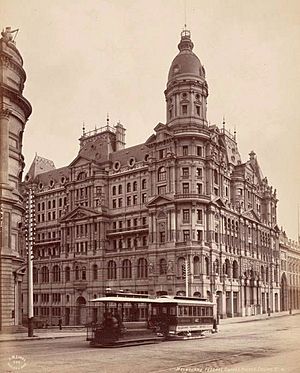
Melbourne's cable tram system began with the MTOC in 1877. The company got permission to run a cable tram system in 1883. The city's councils formed the Melbourne Tramways Trust (MTT) to build the tracks and engine houses. The MTOC then ran the trams.
The first cable tram line opened on November 11, 1885. It ran from Bourke Street to Hawthorn Bridge. By 1891, the system was one of the largest in the world. It had 75 kilometers (47 miles) of double track and 17 routes.
In 1916, the Melbourne Tramways Board (MTB) took over the cable network. Then, in 1919, the Melbourne & Metropolitan Tramways Board (MMTB) was formed and took control. From 1924, the cable tram lines were slowly changed to electric trams or replaced by buses. The very last cable tram in Melbourne ran on October 26, 1940.
The First Electric Trams
The first electric tram in Melbourne was built in 1889 by a group of land developers. It ran from Box Hill railway station to Doncaster. However, this project had many problems and stopped running in 1896.
Electric trams returned on May 5, 1906, with a line from St Kilda to Brighton. A few months later, on October 11, 1906, the North Melbourne Electric Tramway & Lighting Company (NMETL) opened its system. This marked the start of electric trams running continuously in Melbourne.
Victorian Railways Electric Street Railways
The Victorian Railways tram line was built using a wider track size than the cable trams. It connected to the St Kilda railway station, allowing trams to be serviced at Jolimont Yard. This line opened in two parts in 1906.
A fire at the Elwood tram depot in 1907 destroyed all the trams there. Services continued using trams borrowed from Sydney until new ones were built. This "Street Railway" closed on February 28, 1959, and buses replaced it.
VR also opened a second electric tramway in 1919 from Sandringham railway station to Black Rock. This line was extended to Beaumaris in 1926 but closed in 1956.
North Melbourne Electric Tramway & Lighting Company
The NMETL was a company that provided both electricity and tram services from 1906 to 1922. The Melbourne & Metropolitan Tramways Board (MMTB) took over its tram section in 1922.
The NMETL built its system after local people voted for it. It opened on October 11, 1906, with two routes. One went to Essendon and the other to Saltwater River (now Maribyrnong River). The system was about 7 miles (11 km) long and used 25 motor trams and 10 trailers.
The Tramway Trusts
Because people in suburbs like Prahran and Malvern wanted better public transport, the Prahran & Malvern Tramways Trust (PMTT) was created in 1907. Construction began in 1909, and the first trams ran on May 30, 1910. This network used overhead wires for electricity and grew quickly.
Other local trusts were formed later, including:
- Hawthorn Tramways Trust (1914)
- Melbourne, Brunswick & Coburg Tramways Trust (1916)
- Fitzroy, Northcote & Preston Tramways Trust (1920)
- Footscray Tramway Trust (1920)
Melbourne & Metropolitan Tramways Board
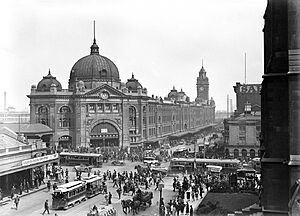
The Melbourne & Metropolitan Tramways Board (MMTB) was formed in July 1919. It took control of all of Melbourne's tram systems: cable, electric, and the last horse tram. By 1940, all cable and horse tram lines were either closed or changed to electric trams or buses.
The MMTB worked to connect and improve the different tram systems. They built the Preston Workshops to make and maintain new trams, like the famous W-class tram introduced in 1923.
The MMTB also helped develop Wattle Park in the 1920s and 1930s, which encouraged more people to use trams. While other Australian cities started getting rid of their trams after World War II, Melbourne kept its network. In fact, new lines opened in the 1950s.
Tram use in Melbourne reached its highest point in 1949 with 260 million trips. Even though numbers dropped later, Melbourne kept its trams for several reasons:
- The city's wide, straight streets were good for trams.
- Unions resisted closing the lines.
- The head of the MMTB, Sir Robert Risson, argued that it would be too expensive to remove the tracks.
- The tram system was relatively new, having replaced older cable trams.
By the mid-1970s, as other cities faced traffic and pollution problems, Melbourne felt it had made the right choice. The first new tram line extension in over 20 years opened in 1978. Older W-class trams were slowly replaced by newer Z-class, A-class, and B-class trams.
In 1980, a report suggested closing seven tram lines, but public protests stopped this from happening.
Changes and Upgrades
On July 1, 1983, the MMTB joined with the city's train system to form the Metropolitan Transit Authority (MTA). This group worked to coordinate all of Melbourne's public transport. The MTA introduced new green and yellow colors for trams and a new ticket system.

In 1985, a system was added to track trams, which helped reduce delays and improve service. In 1987, the St Kilda and Port Melbourne train lines were changed into light rail lines for trams. This involved changing the track width and electrical system.
In 1989, the MTA merged with another transport group to form the Public Transport Corporation (PTC). In the early 1990s, there was a big strike when the government tried to remove tram conductors, but the conductors stayed for a while.
Later, in the mid-1990s, the government planned to privatize the PTC. Tram conductors were replaced by ticket machines between 1996 and 1998, just before the system was sold to private companies.
Private Operators Take Over

On July 1, 1997, Melbourne's tram network was split into two businesses: Swanston Trams and Yarra Trams. These were then sold to private companies for 12-year contracts in 1999. Swanston Trams became M>Tram.
However, M>Tram struggled to make a profit. In December 2002, its owner decided to stop running the trams. The government temporarily took over until Yarra Trams agreed to operate the entire network from April 18, 2004.
On June 25, 2009, Keolis Downer won the contract to operate the Melbourne tram network. They ran the trams until 2024, when Yarra Journey Makers took over.
System Improvements
As part of the privatization, the private companies had to upgrade the tram network. They bought new low-floor trams, like the Siemens Combino (D-class) and Alstom Citadis (C-class), and updated the older trams.

In 2003, the Metlink brand was created to help coordinate information for all of Melbourne's public transport. This included timetables, connections, and ticket information.
Since privatization, the tram system has been extended. For example, the Route 109 was extended to Box Hill in 2003, and Route 75 was extended to Vermont South in 2005.
In 2010, Bombardier Transportation won a contract to build 50 new E-class trams. These trams are 33 meters long and can carry 210 passengers. They are built in Bombardier's Dandenong factory. The first E-class trams started running in November 2013.
In 2012, Public Transport Victoria (PTV) was formed. PTV is in charge of managing and improving Victoria's public transport services, including trams.
Since privatization, the number of tram passengers has greatly increased. In 1999–2000, there were 127.3 million trips, and this number grew to 182.7 million by 2012–2013. New accessible tram stops have also been built to make it easier for everyone to use the trams.
The Metcard ticketing system was replaced by the myki card in December 2012. Myki has been used on trams and buses since July 2010.
Recent Developments
In 2015, the Free Tram Zone was introduced. This allows free tram travel within the city center, Docklands, and the Queen Victoria Market. This helps tourists move around easily. Between 2015 and 2019, 50 more E-Class trams were ordered, bringing the total to 100.
In April 2018, the government announced plans for a new tram line extension from Caulfield. This 18-kilometer (11-mile) extension would serve areas like Chadstone and Monash University. In 2019, plans were also made for two new tram lines to the Fisherman's Bend area.
In 2020, six tram stops on Nicholson Street in Carlton were rebuilt to be low-floor and accessible. This is part of a project to make Route 96 fully accessible. However, by 2021, most tram stops were still not accessible for people in wheelchairs.
In the 2020–21 budget, the government announced $1.48 billion for 100 new G-class trams. These trams will replace older models and are expected to start service in 2025. A new maintenance depot is being built at Maidstone to house these new trams. The G-class trams will be shorter than the E-Class and will use new technology to save power.
Tram Routes
Melbourne's tram network has 24 numbered routes that run regularly. Sometimes, route numbers might have an 'a' or 'd' added. An 'a' means the tram ends early or takes a different path due to delays or special events. A 'd' means the tram is heading back to its depot at the end of its service.
| Route | Terminus A | via | Terminus B | Full length | |
|---|---|---|---|---|---|
| 1 | East Coburg | Brunswick East – Carlton – City – South Melbourne | South Melbourne Beach, Albert Park | 13.2 km (8.2 mi) | |
| 3 | Melbourne University, Carlton | City – Balaclava – Caulfield North | Malvern East | 14.9 km (9.3 mi) | |
| 5 | Melbourne University, Carlton | City – Windsor – Armadale | Malvern | 12.6 km (7.8 mi) | |
| 6 | Moreland railway station, Brunswick | Brunswick East – Carlton – City – Prahran – Armadale – Malvern | Glen Iris | 19.0 km (11.8 mi) | |
| 11 | West Preston | Thornbury – Northcote – Fitzroy – City | Victoria Harbour, Docklands | 13.3 km (8.3 mi) | |
| 12 | Victoria Gardens Shopping Centre, Richmond | Richmond – East Melbourne – City – South Melbourne – Middle Park | Fitzroy & Park Streets, St Kilda | 11.3 km (7.0 mi) | |
| 16 | Melbourne University, Carlton | City – St Kilda – Balaclava – Caulfield North – Malvern – Hawthorn | Kew | 20.2 km (12.6 mi) | |
| 19 | Coburg North | Brunswick – Parkville | Flinders Street railway station, City | 10.2 km (6.3 mi) | |
| 30 | St Vincent's Plaza, East Melbourne | City | Central Pier, Docklands | 2.9 km (1.8 mi) | |
| 35 | The District Docklands Shopping Centre | City | The District Docklands Shopping Centre | 7.6 km (4.7 mi) | |
| 48 | North Balwyn | Kew – Richmond – East Melbourne – City | Victoria Harbour, Docklands | 13.5 km (8.4 mi) | |
| 57 | West Maribyrnong | Ascot Vale – Flemington – North Melbourne | Flinders Street railway station, City | 11.6 km (7.2 mi) | |
| 58 | Pascoe Vale South | Brunswick West – Parkville – City – Southbank – South Yarra | Toorak | 18.2 km (11.3 mi) | |
| 59 | Airport West | Essendon – Moonee Ponds – Travancore – Parkville | Flinders Street railway station, City | 14.7 km (9.1 mi) | |
| 64 | Melbourne University, Carlton | City – Windsor – Armadale – Caulfield | Brighton East | 16.1 km (10.0 mi) | |
| 64a | Orrong & Dandenong Roads, Armadale (after 6:30 pm) | Caulfield | 6.9 km (4.3 mi) | ||
| 67 | Melbourne University, Carlton | City – Balaclava – Elwood – Elsternwick – Caulfield – Glen Huntly | Carnegie | 12.7 km (7.9 mi) | |
| 70 | Wattle Park, Surrey Hills | Camberwell – Hawthorn – Richmond – City | The District Docklands Shopping Centre | 16.5 km (10.3 mi) | |
| 72 | Melbourne University, Carlton | City – Prahran – Toorak – Glen Iris – Camberwell | Deepdene | 16.8 km (10.4 mi) | |
| 75 | Vermont South Shopping Centre | Burwood – Camberwell – Hawthorn – Richmond – City | Central Pier, Docklands | 22.8 km (14.2 mi) | |
| 78 | North Richmond | South Yarra – Prahran – Windsor | Balaclava | 6.5 km (4.0 mi) | |
| 82 | Footscray railway station | Maribyrnong – Ascot Vale | Moonee Ponds Junction | 9.2 km (5.7 mi) | |
| 86 | RMIT University Bundoora | Preston – Thornbury – Northcote – Collingwood – Fitzroy – City | The District Docklands Shopping Centre | 22.2 km (13.8 mi) | |
| 96 | Brunswick East | Carlton – City – South Melbourne – Albert Park – St Kilda | St Kilda Beach | 13.9 km (8.6 mi) | |
| 109 | Box Hill Central | Balwyn – Kew – Richmond – East Melbourne – City | Port Melbourne | 19.2 km (11.9 mi) | |
The Tram Fleet
As of May 2023, Melbourne's tram fleet has 520 trams. The way trams are named (like W-class or Z-class) comes from a system started in 1921.
Most of the trams are owned by the Victorian Government. Some newer trams are part of special agreements where they are leased with an option to buy them later.
W-class Trams
W-class trams were first used in Melbourne in 1923. They have a unique "drop center" design, which means the middle part is lower, making it easier to get on and off. A total of 756 W-class trams were built until 1956. They were the main type of tram in Melbourne for 60 years.
In the 1980s, W-class trams started to be replaced. By 1990, they were recognized as a city icon. Selling them overseas for tourist use was stopped in 1993. About 200 retired W-class trams are still stored, and their future is uncertain. Some have been given to museums.
W-class trams have been sent to other countries. Five went to Seattle and operated there from 1982. Nine are part of a tourist service in Memphis, USA. Other US cities also have one or two. One W-class tram operates on a heritage line in Edmonton, Canada.
As of January 2015, about 230 W-class trams existed. About 165 were in storage, 27 were ready to use as backup, 12 run on the City Circle route, and 26 were used for regular service. The government has committed money to restore W-class trams.
Z-class Trams
New trams were needed to replace the W-class trams in the 1970s. The Z-class trams, built by Comeng, were introduced in 1975.
- Z1-class: 100 of these trams were built between 1975 and 1979. Passengers didn't like them much because they had few doors. Most Z1-class trams were removed from service by April 2016. Many were sold or given to museums.
- Z2-class: 15 of these were built between 1978 and 1979. They were similar to Z1s but had small changes. The last Z2-class tram was removed from service in April 2016.
- Z3-class: 115 of these trams started service between 1979 and 1984. They had an extra door on each side, which made it easier for passengers to get on and off. They also had smoother acceleration and braking. 111 Z3-class trams are still in service today.
-
A Z1-class tram at Federation Square, Swanston Street.
-
A Z2-class tram at City Square, Swanston Street.
A-class Trams
The A-class trams were built by Comeng between 1984 and 1987.
- A1-class: 28 trams entered service between 1984 and 1985. They used trolley poles to get power.
- A2-class: 42 trams entered service between 1985 and 1986. These were the first Melbourne trams to use pantographs (a different way to get power from overhead wires).
Almost all of the A-class trams built are still in service.
-
An A1-class tram at Federation Square, Flinders Street.
B-class Trams
Two B1-class trams were built between 1984 and 1985. These trams were designed for light rail lines and could board passengers from both high train platforms and street level. Both B1-class trams were removed from service in 2018.
B2-class trams started service between 1988 and 1994. They were the first Melbourne trams to have air conditioning. All 130 B2-class trams built are still in service today. B-class trams were the first "articulated" trams in Melbourne, meaning they have sections that can bend, like a bendy bus.
C-class (Citadis) Trams
After the tram system became private in 1999, new trams were bought.
- C1-class: In 2001, Yarra Trams introduced these low-floor trams, made in France by Alstom. They have three sections and 36 are in service.
- C2-class: Five of these trams, which have five sections, started running in Melbourne in 2008. They were leased from France and were called 'Bumble Bees' because of their yellow color. They run only on route 96. The Victorian Government bought these trams in 2013. They can hold 54 seated passengers and 150 standing passengers.
D-class (Combino) Trams
The German-made Siemens Combino trams were introduced between 2002 and 2004. Combino trams are low-floor and come in two types:
- D1-class: These have three sections.
- D2-class: These have five sections.
These trams are part of a lease-to-buy agreement.
E-class (Flexity) Trams

The E-class trams are built in Bombardier Transportation's Dandenong factory. They are based on a design from Germany. In 2010, Bombardier won a contract to supply 50 new low-floor trams. These trams are the first Melbourne trams built locally since 1994.
E-class trams are 33 meters long and 2.65 meters wide. They have anti-slip floors, air conditioning, and automatic announcements. They can carry 210 passengers.
The first two E1-class trams started service on November 4, 2013. The last of the first 50 trams entered service in April 2017. In May 2015, the government ordered 20 more E-class trams with small changes to improve safety. As of October 2021, there are 50 E2-class trams in service. A total of 100 E-class trams are currently running.
G-class (Next Generation Trams)
In November 2020, plans were announced for 100 new "Next Generation Trams" at a cost of about $1.5 billion. These new trams will replace older models that are not accessible. The first of these new trams are expected to start service in 2025.
In April 2022, the Victorian Government announced that Alstom would build these 100 new trams and maintain them for 15 years. This project, costing $1.85 billion, also includes building a new maintenance facility at Maidstone. The trams will be known as the G-class. They are designed to use less power than the E-class trams.
How Many People Ride Trams?
This table shows how many passengers used the tram network each financial year. Australia's financial years run from July 1 to June 30.
| Year | 2000–01 | 2001–02 | 2002–03 | 2003–04 | 2004–05 | 2005–06 | 2006–07 | 2007–08 | 2008–09 | 2009–10 | ||
|---|---|---|---|---|---|---|---|---|---|---|---|---|
| Patronage (millions) |
129.4 | 131.9 | 134.7 | 135.9 | 145.3 |
149.6 |
154.9 | 158.3 | 178.1 | 175.5 | ||
| Reference | ||||||||||||
| Year | 2010–11 | 2011–12 | 2012–13 | 2013–14 | 2014–15 | 2015–16 | 2016–17 | 2017–18 | 2018-19 | 2019-20 | ||
| Patronage (millions) |
182.7 | 191.6 | 182.7 | 176.9 | 182.1 | 203.8 | 204.0 | 206.3 | 205.4 | 141.8 |
||
| Reference | ||||||||||||
| Year | 2020–21 | 2021–22 | 2022-23 | 2023-24 | ||||||||
| Patronage (millions) |
60.2 |
82.9 |
147.6 |
154.8 | ||||||||
| Reference | ||||||||||||
Tram Depots
Melbourne's trams are stored and maintained at eight different depots.
| Depot | Routes | Trams | ||
|---|---|---|---|---|
 |
Brunswick |
|
|
|
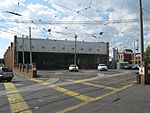 |
Camberwell |
|
|
|
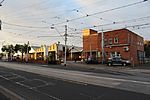 |
Essendon |
|
|
|
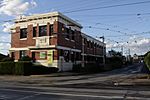 |
Glenhuntly |
|
|
|
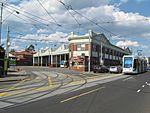 |
Kew |
|
|
|
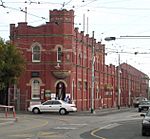 |
Malvern |
|
|
|
 |
Preston |
|
|
|
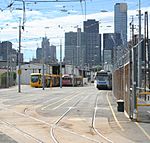 |
Southbank |
|
|
|
| Source: Vicsig | ||||
How Trams Get Power
Melbourne's tram system runs on 600 volts of DC electricity. This power comes from 60 substations located around the network. These substations take electricity from the main power grid and change it into the right voltage for the trams.
The overhead wires are divided into 100 sections. This helps keep the power steady and makes it easier to fix problems if there's a power issue. Common problems include tall vehicles hitting wires, falling tree branches, or damaged poles.
Since 2013, Yarra Trams has been upgrading the substations. This is because newer trams, like the E-class, need more power. They are also planning to divide the power network into even more sections to help isolate problems.
In January 2017, the government announced plans to power Melbourne's tram network using solar power. This power comes from a large solar plant near Mildura.
Where Trams and Trains Cross
Currently, there are two places where tram tracks and train tracks cross at the same level:
- Glenferrie Road, Kooyong
- Riversdale Road, Camberwell
These crossings have special overhead wires that can change voltage. When a train needs to pass, the system switches to 1500 volts for the train. When trams pass, it switches to 600 volts.
In the past, there were many more of these crossings in Melbourne. Most of them have now been separated (one goes over or under the other), or the tram or train line has been closed.
Rules and Safety
Transport Laws
The main law for transport in Victoria is the Transport Integration Act. This law makes sure that all state agencies involved in transport work together. It also requires planning bodies to consider transport when making decisions.
The Act created Transport Safety Victoria (TSV), which is in charge of safety for buses, boats, and trains (including trams) in Victoria. Another important law is the Rail Management Act 1996, which sets rules for managing Victoria's rail tracks.
Safety Rules
The safety of tram operations in Melbourne is controlled by the Rail Safety Act 2006. This law applies to all rail operations in Victoria.
The Act sets out safety duties for everyone involved in the rail industry. Operators must be approved and have a safety management system to guide their work. If they don't follow the rules, there are penalties.
The Director, Transport Safety is the safety regulator for the rail system, including trams. The Chief Investigator, Transport Safety also investigates rail safety issues, like accidents or ongoing problems, to find out what happened without blaming anyone.
Tickets and Conduct
Rules about tram tickets in Melbourne are found in the Transport (Ticketing) Regulations 2006 and the Victorian Fares and Ticketing Manual.
Rules about how people should behave safely and fairly on trams are in the Transport (Compliance and Miscellaneous) Act 1983 and the Transport (Conduct) Regulations 2005.
See also
- List of tram and light-rail transit systems
- Proposed Melbourne tram extensions
- Transport in Australia


